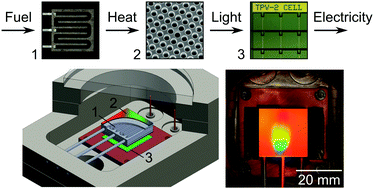Enabling efficient heat-to-electricity generation at the mesoscale†
Abstract
We present a technology that efficiently harnesses the energy content of hydrocarbon fuels in a volume that is only a fraction of a cubic inch. A propane-fueled microcombustor heats a photonic crystal emitter to incandescence and the resulting spectrally-confined thermal radiation drives low-bandgap PV cells to generate electricity. We overcome the technical challenges that are currently limiting thermophotovoltaics in the following ways: we develop new fabrication processes; we adopt high-temperature alloys to improve the thermo-mechanical stability; we adopt commercial polycrystalline tantalum to fabricate large-area photonic crystals; and finally, we develop a passivation coating for improved thermo-chemical stability. We demonstrate unprecedented heat-to-electricity efficiencies exceeding 4%, greater than the 2–3% efficiencies that were previously thought to be the practical limit, and we predict that over 12% efficiency is achievable with only engineering optimization. For reference, a 1.5% efficiency corresponds to the energy density of lithium ion batteries. This work opens new opportunities to free portable electronics, robots, and small drones from the constraints of bulky power sources.



 Please wait while we load your content...
Please wait while we load your content...